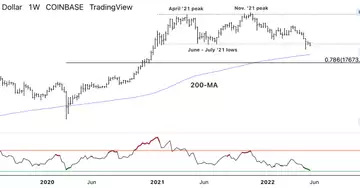Bitcoin (BTC) traded below the $33,000 resistance level last week, although the price stabilized within a narrow range. This could indicate an increase in volatility, similar to earlier this month.
BTC has fallen about 3% in the past week and has outperformed most other cryptocurrencies, suggesting less risk appetite among traders. Typically, BTC falls less than alternative cryptocurrencies in down markets due to its lower risk profile.
The Relative Strength Index (RSI) on the weekly chart is more oversold than it has been since March 2020, when a strong crypto rally preceded it. This time, however, the deterioration in long-term momentum suggests limited upside potential for BTC.
Given the negative momentum readings based on weekly and monthly price data, there is a growing risk of further price declines. Should a volatile downward move occur, initial support is seen at $25,000, which is similar to the May 9 price low. Further support is provided by the 200-week moving average, currently at $22,061, which could stabilize price action.
A more meaningful downside target would be the $17,673 level, which corresponds to about 78% of the previous uptrend from May 2020 to November 2021. This price level would also result in a decline of about 73% from peak to trough, which could represent a capitulation. Bitcoin fell 83% from its all-time high of $19,890 during the 2018 crypto bear market.

